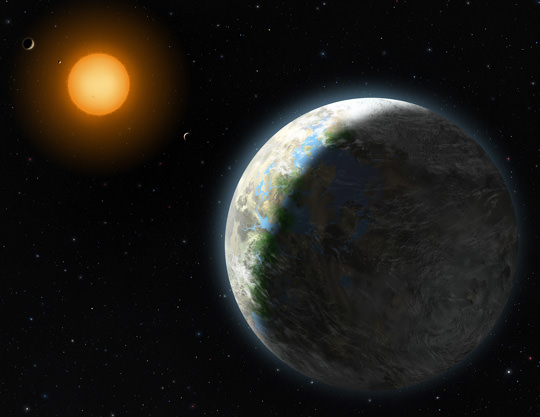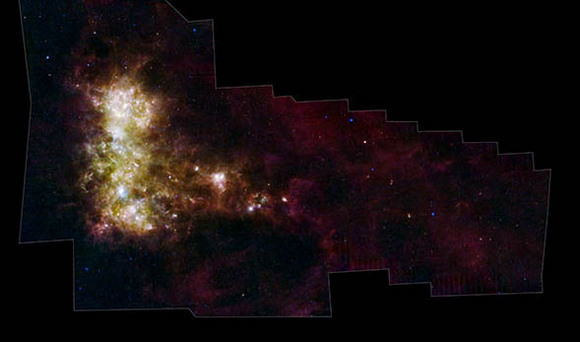A year ago, researchers from the IBEX mission – NASA’s Interstellar Boundary Explorer – announced the discovery of an unexpected bright band or ribbon of surprisingly high energy emissions at the boundary between our solar system and interstellar space. Now, after a year of observations, scientists have seen vast changes, including an unusual knot in the ribbon which appears to have ‘untied.’ Changes in the ribbon — a ‘disturbance in the force,’ so to speak, along with a shrunken heliosphere, may be allowing galactic cosmic rays to leak into our solar system.
Continue reading “Mysterious Ribbon at Edge of Solar System is Changing”
Additional Shuttle Mission Almost Guaranteed
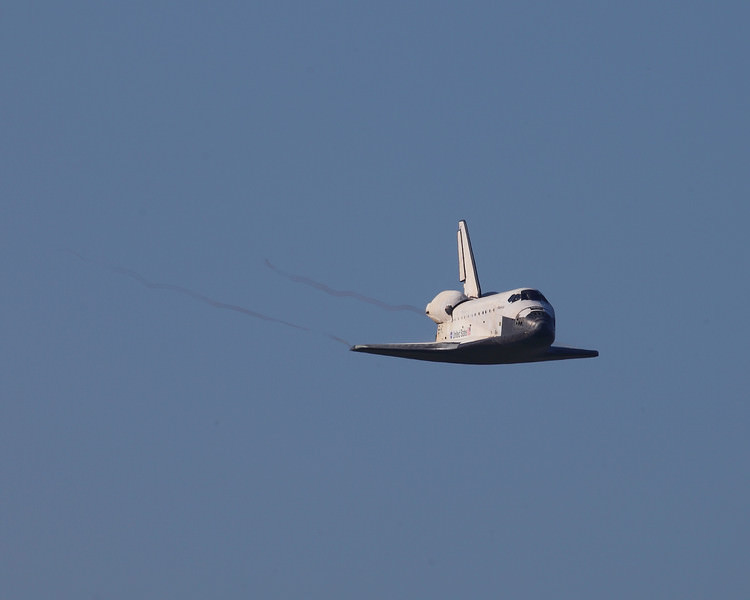
[/caption]
For some time now there have been rumors and speculation that there will be an additional flight added to the two currently remaining on the shuttle manifest. With the passage of the Senate 2010 NASA Authorization Act (S. 3729) the mission which would be STS-135 – is now all but a certainty. The U.S. House of Representatives approved the Senate bill on a 304 to118 vote. The final hurdle will be the president signing the act into law. From all accounts however, as this bill largely supports the president’s agenda, this should not be a problem and STS-135 should launch during the summer of next year.
The orbiter that will likely fly this mission will be Atlantis, the workhorse of the shuttle fleet. For all intents-and-purposes STS-132, which flew this past May, was the last scheduled mission for Atlantis. However, mission managers were looking at either Discovery or Atlantis to fly the possible STS-135 mission. With Atlantis back at Kennedy Space Center (KSC) since May, the orbiter has had more processing time and it would be easier to prepare for launch.
The crew for this mission has already been selected. The crew will be comprised of Commander Chris Ferguson, Pilot Doug Hurley and Mission Specialists Sandra Magnus and Rex Walheim. All of these astronauts are space shuttle veterans. Currently they are training under the STS-335 designation which is a “Launch-On-Need” (LON) mission. In the event of an emergency on STS-134, Atlantis would launch to rescue the crew members. There have been LON missions for each post-Columbia flight.
“Having an additional shuttle flight will keep the national treasure we have in the space station very well situated in consumables and supplies, said Lori Garver, NASA’s Deputy Administrator, during a media briefing on Thursday. “I don’t see it as either a luxury or necessity, it us just making good use of a resource and doing it in a safe manner.”
If all goes well on the STS-134 mission, STS-335 will be converted to STS-135 and its mission will change from rescue – to resupply. If this does take place, the payload for this mission will be the Raffaello Multi-Purpose Logistics Module (MPLM) and a Lightweight Multi-Purpose Carrier (LMC).
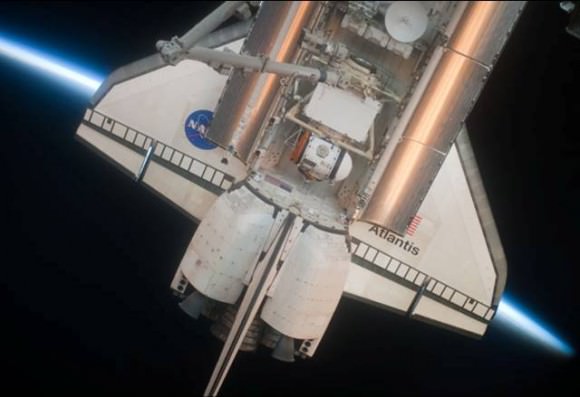
Outside of the fact that it will be the last mission of the shuttle program, the mission also bears one other distinction. With a crew of four, this is the smallest contingent of astronauts to launch on a space shuttle since STS-6 back in April of 1983.
The rationale behind such a small crew is two-fold. A smaller crew will allow NASA to maximize the amount of payload that is sent to the International Space Station (ISS). The weight of two or three extra astronauts will now go to additional supplies that can be flown to the ISS. In the event that STS-135 itself runs into trouble while on-orbit, the smaller crew would also allow for a rescue by the Russian-built Soyuz spacecraft.
The ISS will more than likely be on-orbit until 2020 and possibly beyond. As such it was viewed as essential that as much supplies as possible were ferried to and stored on the orbiting outpost. The Rafaello MPLM will be maxed out with 16 resupply racks, the most the cargo container can handle, for this mission. The LMC will carry a new coolant pump. The External Thermal Cooling System (ECTS) Pump Module (PM) which dramatically failed recently and was swapped out by spacewalkers Tracy Caldwell-Dyson and Doug Wheelock last month.
Could Chance for Life on Gliese 581g Actually Be “100%”?
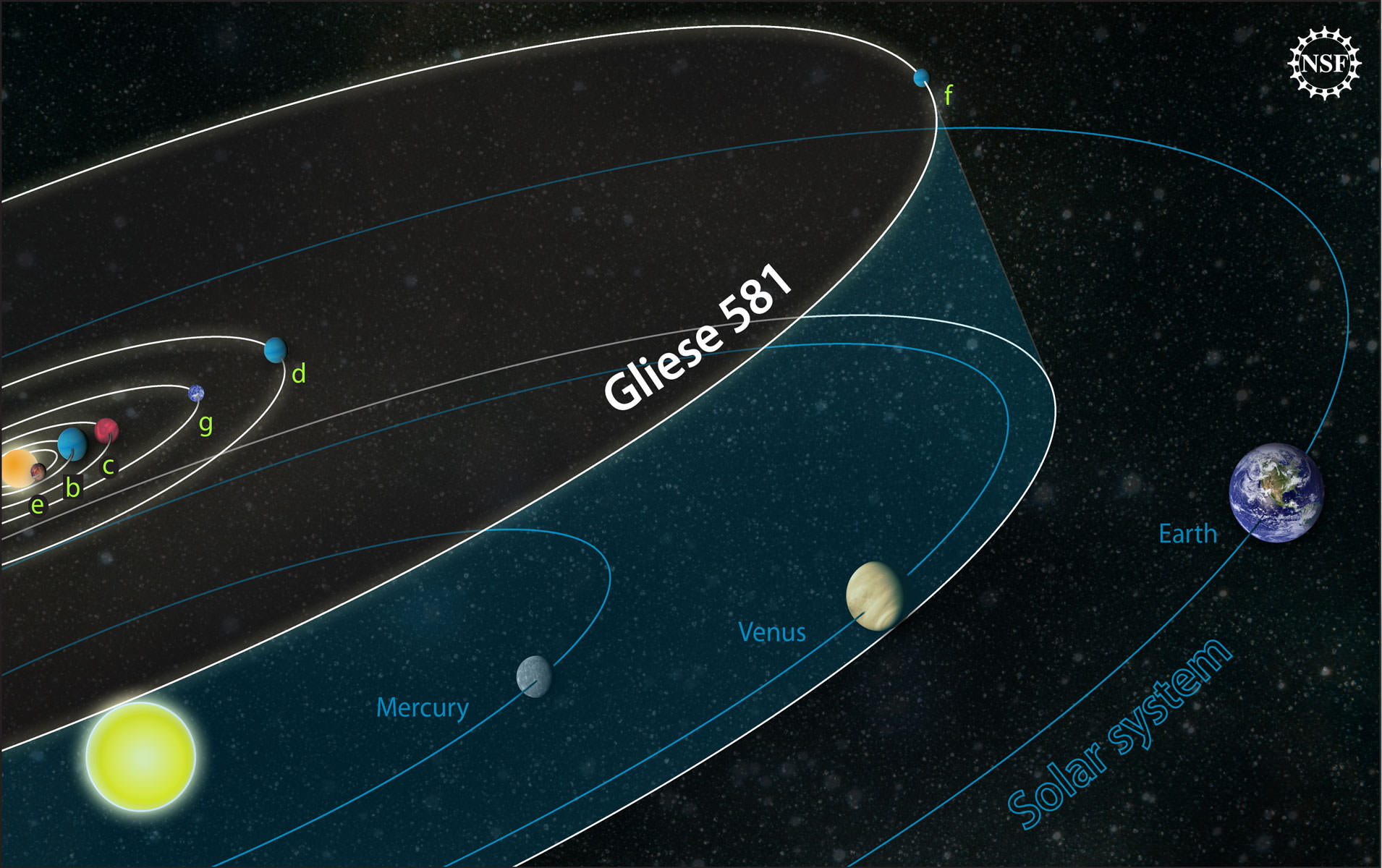
[/caption]
The announcement yesterday of the discovery of the closest Earth-sized planet found so far that also exists in the habitable zone around its star is certainly exciting (read our previous article for all the details). Gliese 581g is surely a potential habitable planet where liquid water could exist on the planet‘s surface, and many are touting the old adage of where there’s water, there’s life. However, some quotes from one of the scientists involved in the discovery might be feeding some wild speculation about the potential for life on this extrasolar planet and elsewhere. “Personally, given the ubiquity and propensity of life to flourish wherever it can, I would say, my own personal feeling is that the chances of life on this planet are 100 percent,” said discoverer and astronomer Steven Vogt during a press briefing yesterday. “I have almost no doubt about it.”
Yes, that is an exact quote. He really used those words. He also said that it would be pretty hard to imagine that water wouldn’t exist on the planet, given the ubiquity of water in our solar system and beyond, and the habitable region in which this planet orbits.
Also participating in the briefing was Paul Butler of the Carnegie Institution of Washington, which provided funds for the observations at the Keck I telescope, and his comments were more tempered.
“Any discussion of life on at this point is purely speculative,” Butler said. “What we know is that this planet exists at the right distance for liquid water it has the right amount of mass to hold on to its atmosphere and any liquid water on the surface. So any subsequent discussion of life there is purely speculative. That being said, on the Earth anywhere you find liquid water you find life in overwhelming abundance. The question should be, if this planet has liquid water, how can you rule out life doesn’t exist? It is pretty probable that anywhere you find liquid water pooling, that you would find life existing.”
Are Vogt’s claims too extreme, or were they made in exhilaration during an exciting announcement? This has been a topic of debate on Twitter this morning. Some wondered if Vogt had been misquoted, and many expressed that Vogt’s words may fuel off-the-deep-end speculation about the certainty of life on another world.
“Until we know more about this planet and the origin of life itself, any claim of certain habitation is idiotic and does not serve science,” said Dr. Stuart Clark (@DrStuClark), author and astronomy journalist. To clarify, he wanted others to know that he thinks just the claim is idiotic, not the discovery or the people involved.
“As cool as it is, please realize that right now all we really know about it is its orbit and estimated mass. That’s it.” said Lee Billings (@leebillings), editor at Seed Magazine. “In other words, barring observational evidence that may still be a generation away, Gliese 581g is ‘Earth-like’ only in terms of mass/orbit.”
From our pal Phil Plait, the Bad Astronomer (@badastronomer): “I understand what he meant – he thinks it could have life – but it was phrased unfortunately, and the media have jumped on it, of course.”
From David Masten (@dmasten), CEO of the commercial space company Masten Space Systems: “I have an opinion or 3 about life on anything in Gliese 581! And I’d dare say much closer to zero chance. But I’m not an astrobiologist.”
“Claiming a 100% chance of life on Gliese 581g is definitely an overreach,” said astrophysicist Juan Cabanela (@Juan_Kinda_Guy) at Minnesota State University Moorhead, “given we currently have a sample of 1 planet with life.”
“Vogt’s extrapolation was certainly quite a leap. On the other hand, the media might finally get it that some scientists really do think life everywhere is possible – but not bug-eyed aliens” said Robert Cumming, (@maltesk), journalist at the Swedish magazine “Populär Astronomi.“. “Then we can also discuss why there might not be life everywhere after all.”
Mark Thompson (@PeoplesAstro), Astronomy presenter on BBC’s the One Show said the Vogt’s quote was “absolutely and totally inappropriate. We can’t even be 100% sure it’s made of rock!!!”
From astronomer, educator and journalist Nicole Gugliucci (@noisyastronomer): “The public seems to have enough trouble trusting science these days without scientists making bold statements like that.”
“100% is ridiculous,” Tweeted frequent image contributor to Universe Today, Stu Atkinson (@mars_stu). “No possible way anyone could know that, surely?”
Many expressed excitement over the discovery, and Stu articulated perhaps the most colorful, which was re-tweeted several times yesterday: “Ah, a PROPER planet!” Not a great fat bloated sweaty “Who ate all the pies” ‘hot Jupiter’ tearing insanely around its star.”
What are your views?
*all Tweets used by permission.
Here’s an article about abiogenesis, theories about how life got started here on Earth.
House Passes Senate Version of NASA Budget Bill
[/caption]
The US House of Representatives voted late Wednesday to accept the Senate’s version of NASA’s $19 billion fiscal 2011 budget proposal. The bill will now go to President Obama for his approval and signature, and if approved would provide $60 billion for NASA over the next three years, with money for development of commercial spacecraft, a heavy lift vehicle for NASA, technology development – including in-space tech such as fuel depots – and one additional shuttle flight in 2011. The Constellation program would be officially dead, although the Orion capsule would still be developed, and the next human destination in space will likely be an asteroid.
The House voted 304 to 118, with no amendments allowed, in favor to approve the budget in a final series of votes before Congress recesses for the November 2 mid-term elections. The bill would keep most of the major changes in NASA’s future that Obama proposed in February of this year, while giving better direction as to where, when and how.
You can see a list of how the representatives voted at this link.
$3.99 billion of the new budget would go towards exploration in fiscal 2011, $1.3 billion for a new deep space capsule and $1.9 billion for initial development of a new heavy lift rocket.
Additionally,the bill would provide $144 million to support on-going development of unmanned spacecraft to deliver cargo to the International Space Station and $312 million for commercial crew spacecraft. Space operations would receive $5 billion, including $2.8 billion for the International Space Station.
NASA Administrator Charlie Bolden was understandably relieved and ecstatic about the passage.
“This important vote today in the House of Representatives on a comprehensive NASA authorization charts a vital new future for the course of human space exploration,” Bolden said in a statement. “The President has laid out an ambitious new plan for NASA that pioneers new frontiers of innovation and discovery. The plan invests more in NASA; extends the life of the International Space Station; launches a commercial space transportation industry; fosters the development of path-breaking technologies; and helps create thousands of new jobs. Passage of this bill represents an important step forward towards helping us achieve the key goals set by the President. “
“This is a great night for our nation’s space program,” Sen. Bill Nelson, a Florida Democrat, said in a statement. “This bill is a blueprint for how we will proceed for the next three years and will allow NASA to begin planning for an extra shuttle flight. Now we have to make sure the agency gets the funding necessary to get the job done.”
There were some critics of the bill however. Former NASA administrator Mike Griffin said in an article in the Huntsville Times this week, “While it is true that the Senate bill offers some improvement over the Obama administration’s ill-advised plan for NASA, in my considered opinion it is not enough better to warrant its support in law. As happened after the loss of space shuttle Columbia, it is time once again to ask ourselves whether we want to have a real space program, or not. If we do, then the Senate bill won’t get us there. If we cannot do better than that, then I believe we have reached the point where it is better to allow the damage which has been brought about by the administration’s actions to play out to its conclusion than to accept half-measures in an attempt at remediation.”
And Rep. Gabrielle Giffords, D-Arizona (who is married to shuttle commander Mark Kelly) said she doesn’t like the idea of Congress deciding what heavy lift vehicle should be built. “In short, the Senate bill forces NASA to build a rocket that doesn’t meet its needs, with a budget that’s not adequate to do the job and on a schedule that NASA’s own analysis says is unrealistic,” she said after the vote Wednesday night. “That is not my idea of an executable and sustainable human spaceflight program.”
She also said the legislation “lacks serious budgetary discipline” and includes an “unfunded mandate to keep the shuttle program going through all of fiscal year 2011 even after the shuttle is retired, which NASA estimates will cost the agency more than half a billion dollars.”
You can read more reactions over at Jeff Foust’s Space Politics website, and see this link from Hobby Space for a plethora of news reports about the bill’s passage.
Sources: NASA, AFP Spaceflightnow.com
New Earth-sized Exoplanet is in Star’s Habitable Zone
[/caption]
An enticing new extrasolar planet found using the Keck Observatory in Hawaii is just three times the mass of Earth and it orbits the parent star squarely in the middle of the star’s “Goldilocks zone,” a potential habitable region where liquid water could exist on the planet’s surface. If confirmed, this would be the most Earth-like exoplanet yet discovered and the first strong case for a potentially habitable one. The discoverers also say this finding could mean our galaxy may be teeming with prospective habitable planets.
“Our findings offer a very compelling case for a potentially habitable planet,” said Steven Vogt from UC Santa Cruz. “The fact that we were able to detect this planet so quickly and so nearby tells us that planets like this must be really common.”
Vogt and his team from the Lick-Carnegie Exoplanet Survey actually found two new planets around the heavily studied red dwarf star Gliese 581, where planets have been found previously. Now with six known planets, Gliese 581 hosts a planetary system most similar to our own. It is located 20 light years away from Earth in the constellation Libra.
The most interesting of the two new planets is Gliese 581g, with a mass three to four times that of the Earth and an orbital period of just under 37 days. Its mass indicates that it is probably a rocky planet with likely enough gravity to hold on to an atmosphere.
The planet is also tidally locked to the star, meaning that one side is always facing the star in sunlight, while the side facing away from the star is in perpetual darkness. One effect of this is to stabilize the planet’s surface climates, according to Vogt. The most habitable zone on the planet’s surface would be on the terminator, the line between shadow and light, with surface temperatures decreasing toward the dark side and increasing toward the light side.
“Any emerging life forms would have a wide range of stable climates to choose from and to evolve around, depending on their longitude,” Vogt said.
There has been debate about the other planets found previously around Gliese 581, whether they could be habitable or not. Two of them lie at the edges of the habitable zone, one on the hot side (planet c) and one on the cold side (planet d). While some astronomers still think planet d may be habitable if it has a thick atmosphere with a strong greenhouse effect to warm it up, others are skeptical. The newly discovered planet g, however, lies right in the middle of the habitable zone.
“We had planets on both sides of the habitable zone–one too hot and one too cold–and now we have one in the middle that’s just right,” Vogt said.
The researchers estimate that the average surface temperature of the planet is between -24 and 10 degrees Fahrenheit (-31 to -12 degrees Celsius). Actual temperatures would range from blazing hot on the side facing the star to freezing cold on the dark side.
If Gliese 581g has a rocky composition similar to the Earth’s, its diameter would be about 1.2 to 1.4 times that of the Earth. The surface gravity would be about the same or slightly higher than Earth’s, so that a person could easily walk upright on the planet, Vogt said.
The planet was found using the HIRES spectrometer (designed by Vogt) on the Keck I Telescope, measuring the star’s radial velocity. The gravitational tug of an orbiting planet causes periodic changes in the radial velocity of the host star. Multiple planets induce complex wobbles in the star’s motion, and astronomers use sophisticated analyses to detect planets and determine their orbits and masses.
“It’s really hard to detect a planet like this,” Vogt said. “Every time we measure the radial velocity, that’s an evening on the telescope, and it took more than 200 observations with a precision of about 1.6 meters per second to detect this planet.”
In addition to the radial velocity observations, coauthors Henry and Williamson made precise night-to-night brightness measurements of the star with one of Tennessee State University’s robotic telescopes. “Our brightness measurements verify that the radial velocity variations are caused by the new orbiting planet and not by any process within the star itself,” Henry said.
The researchers also explored the implications of this discovery with respect to the number of stars that are likely to have at least one potentially habitable planet. Given the relatively small number of stars that have been carefully monitored by planet hunters, this discovery has come surprisingly soon.
“If these are rare, we shouldn’t have found one so quickly and so nearby,” Vogt said. “The number of systems with potentially habitable planets is probably on the order of 10 or 20 percent, and when you multiply that by the hundreds of billions of stars in the Milky Way, that’s a large number. There could be tens of billions of these systems in our galaxy.”
Source: University of California – Santa Cruz
Here’s an article about abiogenesis, or the beginning of life on Earth.
NASA’s Year of Finales Continues with Last ET and SRB Events
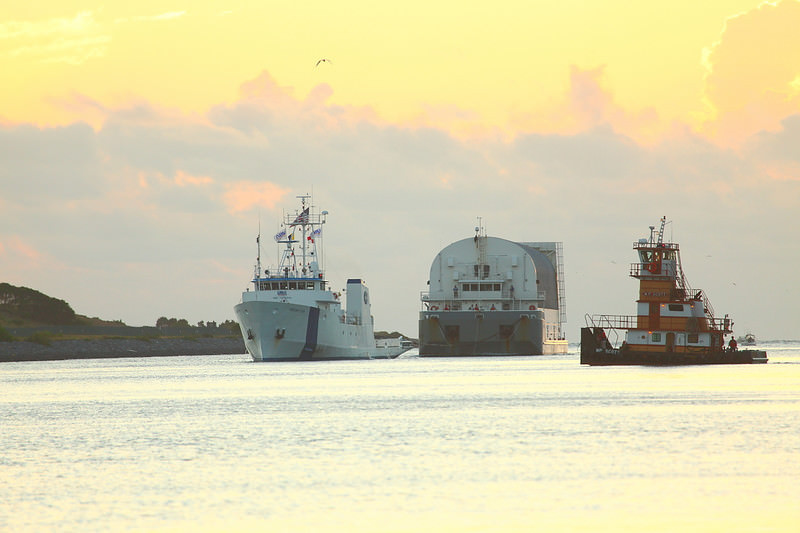
[/caption]
As the space shuttle program draws to a close, NASA is working to highlight the historic nature of each of the events. On Tuesday, Sept. 28th, the last External Tank of the shuttle program wheeled out of the Pegasus Barge – early. Storm clouds had been swirling around the Kennedy Space Center (KSC) in the early morning hours, pushing the rollout time up.
Weather also conspired to delay the departure of the final Solid Rocket Booster (SRB) segment from the Assembly Refurbishment Facility (ARF). After a brief ceremony that included Kennedy Space Center Director Robert Cabana and Astronauts Chris Hadfield and Gregory C. Johnson it was announced that the final SRB segment would wait in the ARF for a couple more days until the weather system passed. The moment seemed to highlight some of the emotions that those that have worked on the SRBs are currently feeling.
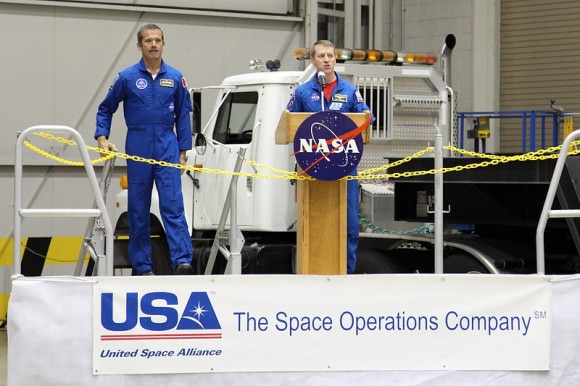
“It’s bittersweet; you know I’ve worked with the people here for the last twenty-years,” said David Beaman the manager for the Reusable Solid Rocket Booster Project, Shuttle Office. “It’s exciting to know that we’ve almost completed the mission, to know that we’re getting ready for the last couple shuttle flights.”
The External Tank traveled from NASA’s Michoud Facility located in Louisiana to NASA’s Kennedy Space Center across the Gulf of Mexico. The trip takes about 5 days and some 900 miles. The Pegasus reached the turn basin near the massive Vehicle Assembly Building (VAB) the day prior. The day was viewed as one of reflection for those that have worked to see that the tanks arrive safely at KSC.
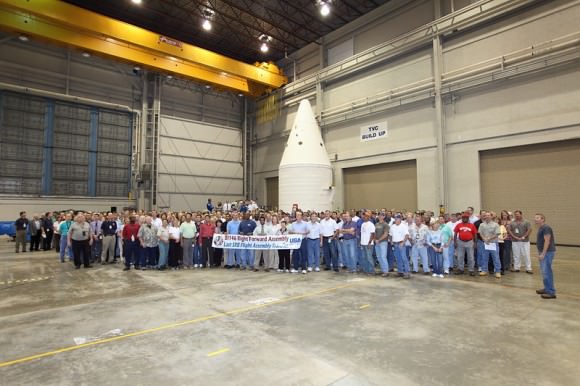
“It’s a sentimental day, almost nostalgic, who knows what the future brings, but at least for the shuttle program this is the last,” said KSC’s External Tank and Solid Rocket Booster Manager, Alicia Mendoza. “We are excited to have the tank, we all had our adrenaline flowing, but at the same time it is sad because it is the last tank.”
While a final determination as to whether or not there will be a third mission added to the two currently scheduled, all signs indicated that this mission will be added. Currently this mission is designated STS-335 and would be a “Launch On Need” (LON) rescue mission for the final scheduled flight of space shuttle Endeavour, STS-134. If and when this mission is given the go-ahead the crew would consist of Commander Chris Ferguson, Pilot Doug Hurley and Mission Specialists Rex Walheim and Sandra Magnus. The crew would convert from training as a rescue mission to a resupply mission for the space station.
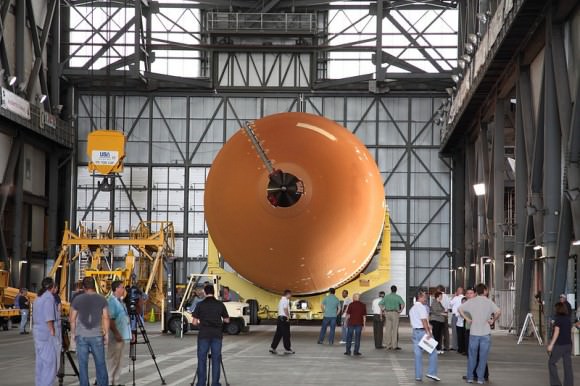
It was Robert Cabana, Kennedy Space Center’s Director that highlighted the importance of the work that was done on both the SRBs and ETs over the past three decades.
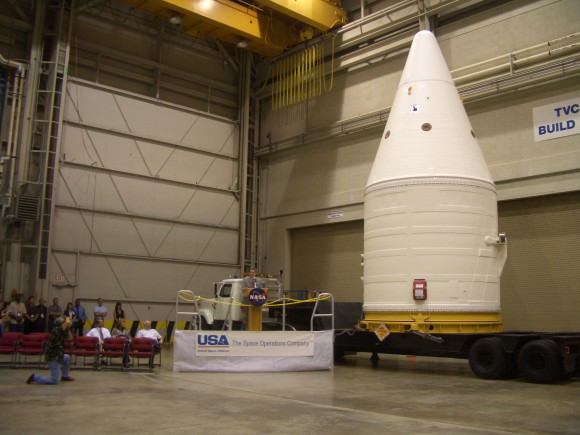
“I just want to say thank you for your hard work and dedication, thank you for thirty years supporting space shuttle operations,” said Cabana, a four-time shuttle astronaut, speaking at Tuesday’s ceremonies. “Thank you for supporting an amazing vehicle that made the assembly of the space station that’s on orbit possible, that put the Hubble Space Telescope up there; that put all the probes out there in space that has done all the things that would not have been possible without the space shuttle.”
Where In The Universe Challenge #120
Here’s this week’s image for the Where In The Universe Challenge, to test your visual knowledge of the cosmos. You know what to do: take a look at this image and see if you can determine where in the universe this image is from; give yourself extra points if you can name the spacecraft or instrument responsible for the image. We’ll provide the image today, but won’t reveal the answer until later. This gives you a chance to mull over the image and provide your answer/guess in the comment section. Please, no links or extensive explanations of what you think this is — give everyone the chance to guess.
UPDATE: Answer is now posted below:
This dusty little galaxy is the Small Magellanic Cloud, as seen in infrared, taken by the Spitzer Space Telescope. In this image you can see stars and dust that haven’t been visible before Spitzer’s infrared eyes took a glance. The Small Magellanic Cloud is a nearby satellite galaxy to our Milky Way galaxy, approximately 200,000 light-years away.
For more info on this image, see the Spitzer website.
Largest Clouds Ever Seen on Titan
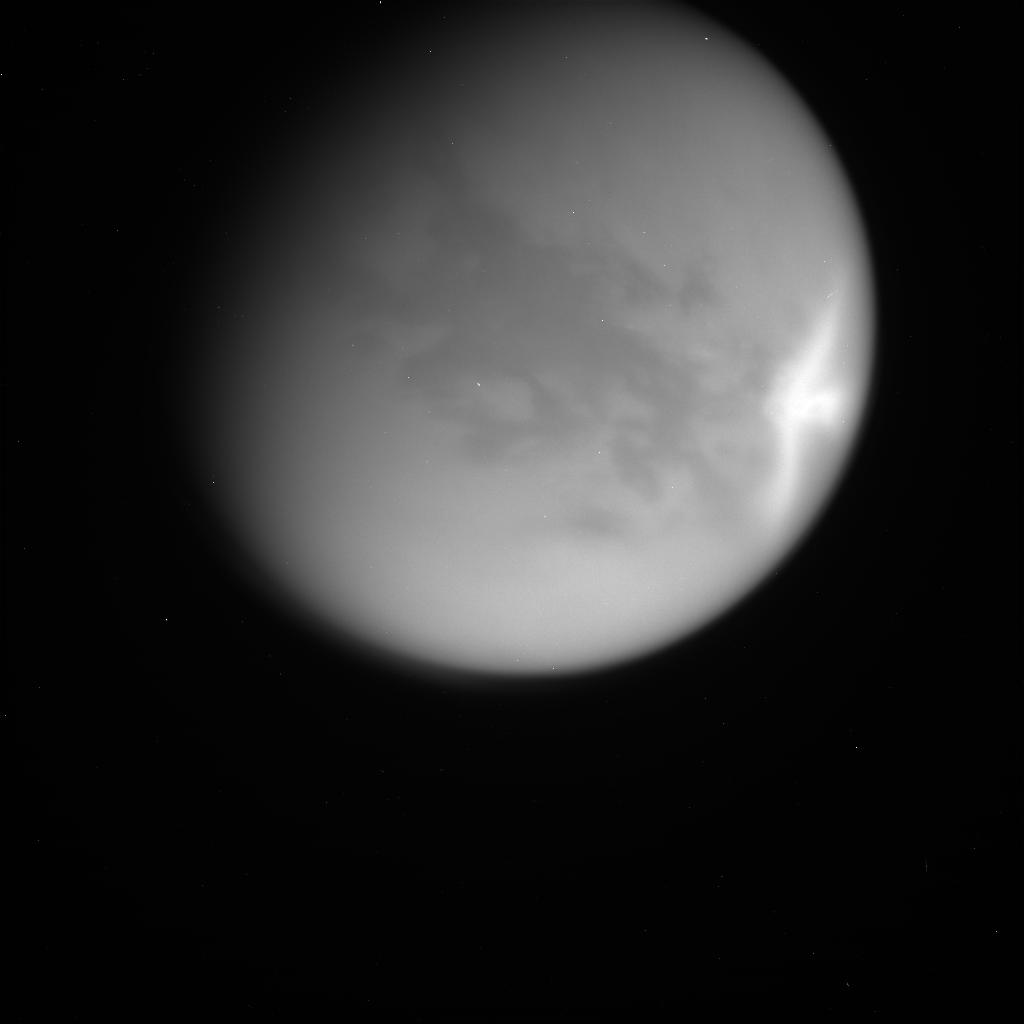
[/caption]
The Cassini spacecraft recently swooped by Saturn’s largest moon Titan and captured images of large patches of clouds. “These are some of the largest clouds our cameras on Cassini have yet seen on Titan!” said Carolyn Porco, Cassini imaging team lead, in an email announcing the image. “And the fact that we see them in the equatorial region is big news and may signify seasonal change is underway!”
The image was taken on September 27, 2010 and received on Earth September 28, 2010 at a distance of approximately 1,282,259 kilometers away. The spacecraft was actually at its closest approach on Sept. 24, and took a long, sustained look at the hazy moon, coming within 8,175 kilometers (5,080 miles) above the hazy moon’s surface.
Cassini’s visual and infrared mapping spectrometer also took a look at these clouds, so look for more information soon about this large region of clouds.
Cassini also used its composite infrared spectrometer instrument to take a look at Titan’s stratosphere to learn more about its vertical structure as the seasons change.
This flyby is the first in a series of high-altitude Titan flybys for Cassini over the next year and a half.
See a larger version of the image at the CICLOPS website.
Carnival of Space #171
This week’s Carnival of Space is hosted by John Williams over at Starry Critters.
Click here to read the Carnival of Space #171.
And if you’re interested in looking back, here’s an archive to all the past Carnivals of Space. If you’ve got a space-related blog, you should really join the carnival. Just email an entry to [email protected], and the next host will link to it. It will help get awareness out there about your writing, help you meet others in the space community – and community is what blogging is all about. And if you really want to help out, let Fraser know if you can be a host, and he’ll schedule you into the calendar.
Milky Way Sidelined in Galactic Tug of War

[/caption]
From a Harvard-Smithsonian Center for Astrophysics press release:
The Magellanic Stream is an arc of hydrogen gas spanning more than 100 degrees of the sky as it trails behind the Milky Way’s neighbor galaxies, the Large and Small Magellanic Clouds. Our home galaxy, the Milky Way, has long been thought to be the dominant gravitational force in forming the Stream by pulling gas from the Clouds. A new computer simulation by Gurtina Besla and her colleagues from the Harvard-Smithsonian Center for Astrophysics now shows, however, that the Magellanic Stream resulted from a past close encounter between these dwarf galaxies rather than effects of the Milky Way.
“The traditional models required the Magellanic Clouds to complete an orbit about the Milky Way in less than 2 billion years in order for the Stream to form,” says Besla. Other work by Besla and her colleagues, and measurements from the Hubble Space Telescope by colleague Nitya Kallivaylil, rule out such an orbit, however, suggesting the Magellanic Clouds are new arrivals and not long-time satellites of the Milky Way.
This creates a problem: How can the Stream have formed without a complete orbit about the Milky Way?
To address this, Besla and her team set up a simulation assuming the Clouds were a stable binary system on their first passage about the Milky Way in order to show how the Stream could form without relying on a close encounter with the Milky Way.
The team postulated that the Magellanic Stream and Bridge are similar to bridge and tail structures seen in other interacting galaxies and, importantly, formed before the Clouds were captured by the Milky Way.
“While the Clouds didn’t actually collide,” says Besla, “they came close enough that the Large Cloud pulled large amounts of hydrogen gas away from the Small Cloud. This tidal interaction gave rise to the Bridge we see between the Clouds, as well as the Stream.”
“We believe our model illustrates that dwarf-dwarf galaxy tidal interactions are a powerful mechanism to change the shape of dwarf galaxies without the need for repeated interactions with a massive host galaxy like the Milky Way.”
While the Milky Way may not have drawn the Stream material out of the Clouds, the Milky Way’s gravity now shapes the orbit of the Clouds and thereby controls the appearance of the tail.
“We can tell this from the line-of-sight velocities and spatial location of the tail observed in the Stream today,” says team member Lars Hernquist of the Center.
The paper describing this work has been accepted for publication in the October 1 issue of the Astrophysical Journal Letters and is available online: Simulations of the Magenllanic Stream in a First Infall Scenario.


